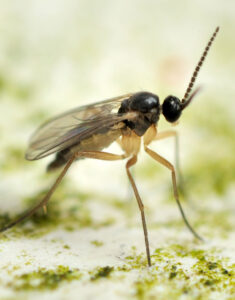
Growing a healthy crop requires a substantial investment of time, money, effort, and resources. One of the biggest challenges to producing the best product are fungus gnats. These micro-sized mosquito look-alikes are insects known as Bradysia spp, and it’s the larvae of these gnats that cause the most problems. The insects most commonly appear in warm, damp locations, especially cannabis plants in over-watered soil.
Unlike many caterpillars that feed on leaves, fungus gnat larvae live on fungus in the topsoil and damage the roots of plants by gnawing on them. This can also lead to secondary infections of bacteria and fungus that further harm the plant. Seedlings and young plants are most at risk of damage from fungus gnats, although even mature plants are at risk from prolonged infestations.
Signs of infestation
Since Bradysia spp are so tiny, spotting an infestation in its early stages isn’t always easy. Proper monitoring is important, since these insects can impact the overall health and quality of your plants. Signs of a fungus gnat infestation include:
– Stunted or abnormal growth
– Drooping yellow leaves, with or without dark spots on the edges
– Limp foliage
– Seedlings that weaken and fall over (“damping off”)
– Slow or reduced bud development in flowering plants
– Small buzzing gnats at the base of the plant
Pest management
Greenhouse and cannabis growers recommend basic steps to manage fungus gnats in their crop:
– Yellow sticky traps placed at the base of plants to catch adult females laying eggs and make it easier to spot an infestation in the earliest stages
– Don’t overwater your plants. Wait until the top layer is completely dry before adding more water. Investing in irrigation systems may also help.
– Diatomaceous earth is a white powder that can be sprinkled around greenhouses, grow rooms, and on the topsoil of most plants. Though harmless to humans, the microscopic surface of the white powder is sharp enough to kill fungus gnats.
AQUABAC products with Bacillus thuringiensis israelensis (Bti) are highly effective against fungus gnat larvae and can be applied directly to the topsoil to kill existing larvae and prevent the development of new ones.

